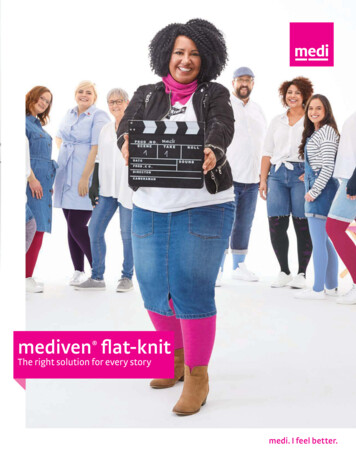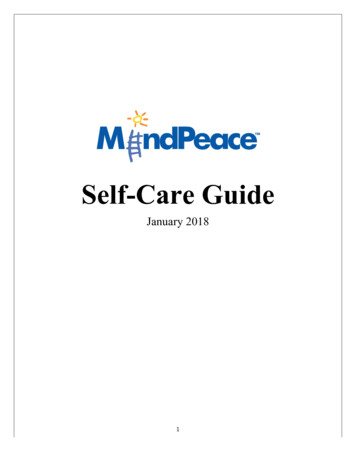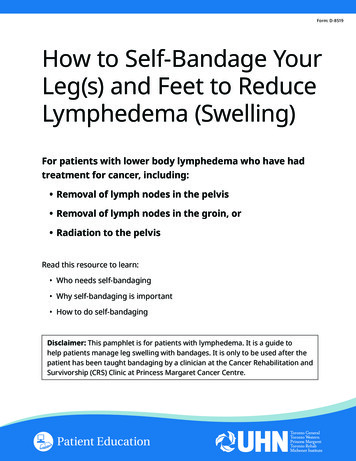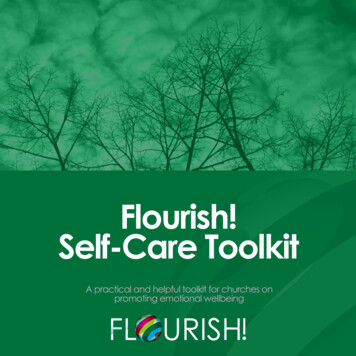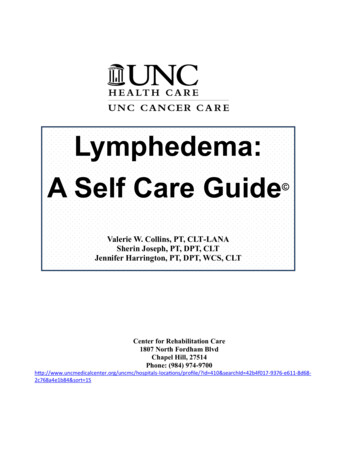
Transcription
Lymphedema:A Self Care Guide Valerie W. Collins, PT, CLT-LANASherin Joseph, PT, DPT, CLTJennifer Harrington, PT, DPT, WCS, CLTCenter for Rehabilitation Care1807 North Fordham BlvdChapel Hill, 27514Phone: (984) itals-locations/profile/?id 410&searchId 42b4f017-9376-e611-8d682c768a4e1b84&sort 15
TABLE OF CONTENTSGeneral InformationWhat is lymphedema and what causes it?How can lymphedema affect my life?What is the lymphatic system and how does it work?What are the risk factors of lymphedema?How does lymphedema change over time?What are the signs and symptoms of lymphedema?Who should I see if I notice swelling changes?Risk ReductionHow can I reduce my risk of lymphedema?Skin care, exercises, clothing, compressionWhat are the signs of skin infection and what should I do?If You Have LymphedemaWhat is the treatment for lymphedema?The four components of treatment1. Manual lymph drainage (MLD)2. Skin careScar care3. Compression therapyGetting garments on4. ExerciseLymphatic ExercisesLymphatic exercises for allLymphatic exercises for arms/head/neckLymphatic exercises for legsWhat else can I do to help my lymphatic system?1. Weight loss2. ExerciseA sample walking program3. Monitoring swelling changesTroubleshooting for increased swellingLymphedema 617181920242
General InformationWhat is Lymphedema and What Causes it?Lymphedema is swelling in a part of the body due to fluid retention. Primary lymphedema is a conditionthat people are born with, but most lymphedema is caused by removal of the lymph nodes or radiation treatment for certain forms of cancer, and this is called secondary lymphedema. Depending on the type of surgery and other treatments a person has, it’s possible for lymphedema to occur in any part of the body. Obesity and untreated vein problems in the legs can also develop into lymphedema. The swelling can be accompanied by pain, limited motion, tightness, numbness, and sometimes infection. Lymphedema can happendays, months, or years after cancer treatment and can be temporary or ongoing.How can lymphedema affect my life?Lymphedema can impact many parts of your life. This booklet is to help you learn what you can do to reduce your risks of lymphedema, how to detect it, and what to do should you develop it so that you can minimize its impact on other aspects of your life. For most cancer survivors, lymphedema has minimal to no effect on their lives. For some, a chronically swollen arm or leg is a visible sign of disability, and they canexperience negative emotions, and develop a negative body image. Severe lymphedema may interfere withone’s ability to perform work and participate in normal daily activities. Financial burdens can result due toinsufficient insurance for treatment and garments.Keep in mind, if you’re experiencing any of these challenges there are resources to help!The resource section of this booklet has local, statewide, and national resources listed. Your local healthproviders may know about other agencies in your area. It can also be helpful to talk to other peopleexperiencing the same thing as you, whether it is a phone call, a support group, online, or a passingconversation. The UNC Lineberger Comprehensive Cancer Support Program has a group of counselors,psychiatrists, psychologists, and nurses that provide compassionate support and symptom management forpsychosocial challenges that can accompany a cancer diagnosis. In addition, a variety of support groups areavailable for both patients and caregivers. Call 984-974-2277 or 984-974-8100 www.unclineberger.org/ccsp3
What is the lymphatic system and how does it work?There are two purposes of the lymphatic system: 1) To clean all the organs and tissues of the body and2) To fight infection.Lymphatic circulationThe heart pumps oxygen rich blood outward from the large tube like vessels called arteries, which continueto get smaller in size until they become capillaries. Fluids and nutrients leak out from the capillaries intotissues to nourish them, then are recycled and brought back into the blood circulation. The veins reabsorb60%-80% of the fluid and the lymphatic system filters and recycles the remaining fluid and waste products.When the lymph system isn’t working correctly,fluid and waste products stay in the tissues andcause increased swelling, scar tissue, and thickening of the skin.The skin’s lymphatic system consists of lymphvessels located in the skin, meeting up with regional lymph nodes located in your neck, armpits,and groin area. As the lymph vessels move fluidout of the tissues, they collect and filter wasteproducts in the nodes, then return clean fluid tothe bloodstream.How the lymph nodes fight infectionThere are 500-700 lymph nodes in the bodypacked tightly with cells that fight infection andfilter waste products. These are dispersed throughout the body, with several hundred in the trunkand abdomen near organs, as well as hundreds in the head and neck region. The skin of the body drains intospecific regional lymph nodes. Lymph fluid from the skin above the waist flows into the right and left armpits (axilla). There are about 10-40 regional lymph nodes in each axilla. The lymphatic fluid from the skinbelow the waist drains into the right and left groin, which hold about 50-70 regional lymph nodes. If lymphnodes are not working properly, the affected limb and trunk are at greater risk for infection because the immune system is not functioning properly in fighting foreign substances.What are the risk factors of lymphedema?It is important to note that lymphedema is not your fault. There are certain risk factors that could possiblyincrease your chances of developing lymphedema, but we still do not understand why someone developslymphedema and another person with the same treatment does not. Below are some risk factors: Number of nodes removed, and the numberwith cancerObesityRadiation and chemotherapyPost-operative infections or seromasGenetics Being younger age at time of diagnosisHypertensionDominant side involvedAxillary web syndrome or cording4
How does lymphedema change over time?Lymphedema may start immediately after surgery, or it may develop years later, or with infections or injuries to theskin.What are the signs and symptoms of lymphedema? Aching, discomfort, soreness or pain in theaffected area Clothing, bras, underwear, jewelry, or shoesfeel tight Feelings of heaviness, fullness, or tightness inthe skin, can’t see the tendons or veins in thehands or feet Swelling that fluctuates and may leave an indentedspot in the skin when pressed Numbness/tingling in the involved limb Less movement or flexibility in a jointWho should I see if I notice swelling changes?Ask your healthcare provider for a referral to see a lymphedema therapist who can assess your swelling.Lymphedema therapists are also physical, occupational, or massage therapists as well. “CLT” after thetherapist’s name indicates that the therapist has attended at least 135 hours of post graduate courses inlymphedema care. “LANA” after the therapist’s name indicates passing a national certification exam.Check with your insurance company to see what services are covered. Find a qualified lymphedematherapist in your area by visiting these sites: www.lymphnotes.comwww.lymphnet.orgwww.clt-lana.org g/patientcare/programs/ccspRisk ReductionHow can I reduce my risk of lymphedema?You cannot completely prevent lymphedema, but you can decrease the stress and strain on your lymphaticsystem by following these common sense guidelines to care for yourself, adapted from the NationalLymphedema Network (NLN). See the next page for a sheet you can take with you with risk reduction tips.The majority of these recommendations are based on knowledge of the pathophysiology and decades of clinical experience byexperts in the field, but there is currently little evidence-based literature on many of these practices.5
Risk ReductionSKIN CARE: Avoid trauma or injury in the affected area to reduce infection risk Keep skin clean & moisturized. Watch temperature changes: No piercings or tattoos in the affected area Take care with shaving and nail/cuticle care. Be care-AVOID prolonged exposure to heat (greater than 15ful of pet scratchesminutes), particularly hot tubs & saunas, placing the at Wear gloves when doing activities that may causerisk area in water temperatures above 102 F, & exposkin injury (i.e. dishes, working in the garden or withsure to extreme outdoor hot or cold when outdoorstools, using chemicals) Protect exposed skin, use sunscreen & insect repellent If scratches/punctures occur, wash skin with soap and Inform your health care providers about lymphedema,water, apply antibiotics and observe for signs of inincluding massage therapists. When possible, nofection (see below)injections, acupuncture, or blood pressure cuffs on the Use an electric razor for shaving the face and neck ifaffected limbyou have head or neck cancer treatmentsACTIVITIES/EXERCISE/LIFESTYLE: Gradually build up duration and intensity of exercise and take frequent rest breaks to allow for limb recoveryMonitor at risk area during and after activity for changes in size, shape, skin texture, soreness, or heavinessMaintain optimal body weight. Obesity is a major lymphedema risk factor.Avoid carrying a heavy bag or purse on the affected sideDrink 48 oz. of water a day to prevent dehydration and worsening of lymphedemaFor head and neck cancer patients: Avoid straining to lift objectsCLOTHING/COMPRESSION: Wear non-constrictive jewelry and clothingCompression garments should be well fittingSupport the at-risk limb with a compression garment for strenuous activity (weight lifting, prolonged standing,running) or repetitive activity (gardening, raking, sports)Those with lymphedema should wear a compression garment for air travelPreventive garments may be helpful for the at-risk limbADDITIONAL PRACTICES SPECIFIC TO LEG LYMPHEDEMA: Avoid prolonged standing, sitting, or crossing legs Wear well-fitting footwear without heelsWHAT ARE THE SIGNS OF SKIN INFECTION ANDWHAT SHOULD I DO? Fever, vomiting, chills, red and hot skin Itching, rash, fungal infections, or any other unusual changes on the skin of theaffected body part Increase in swelling in the affected area Pain in the affected quadrantIf any of these things happen call your doctor. If your doctor is not available, go to a walk-in clinic or emergency room. Antibiotics are necessary to treat the infection and time is critical. Remove any compressionand do not perform self manual lymph drainage as this could spread the infection. Compression and MLDcan be restarted when the infection has been cleared by your doctor.6
If You Have LymphedemaWhat is the treatment for lymphedema?Although there is no cure for lymphedema, it can be effectively managed. Treatment regimens vary, depending on the severity of swelling and condition of the skin, and may require several weeks to months of therapeutic care. Whether you are seeing a therapist, or doing self-care there are four components of treatment,MANUAL LYMPH DRAINAGE, SKIN CARE, COMPRESSION, and EXERCISE.Treatment is performed in two phases:1. The intensive phase: (You are under the care of a therapist)The goals of the first phase are to reduce the swelling, improve tissue health and fit proper compression garments and devices. During this time, your therapist will perform manual lymphatic drainage (MLD), usesome form of compression therapy, and teach you self care techniques to include skin care and exercises toassist with lymphatic drainage. If your swelling is severe, you may require Complete DecongestiveTherapy. Your therapist will give you more instructions if this type of therapy is deemed necessary.2. The self-management phase: (You are taking care of yourself)The goals of the second phase are to keep the improvements made during the intensive phase and managethe lymphedema. Once reduction in swelling is completed you are expected to be able to take care ofyourself independently or with a caregiver. You may need occasional checkups should problems arise.The Four Components of TreatmentMANUAL LYMPH DRAINAGE (MLD)MLD is a very gentle, but highly effective medical massage technique, that encourages the natural circulation of the lymph through the body, following the normal lymphatic pathways to improve the overall functioning of the lymphatic system. Manual Lymph Drainage is a very detailed, light, slow and rhythmicmassage that stimulates the flow of lymph fluid in the vessels and nodes of the lymph system. The directionand order of the MLD technique is as important as the gentle strokes. Most patients are pleasantly surprisedat their body’s response to this gentle technique. MLD works!Question: Why should I learn MLD and perform it daily?Answer: MLD relaxes heart rate, blood flow, and breathing rates. MLDpromotes the movement of fluid and waste products out of the skin so itkeeps skin from swelling or getting hard. MLD also stimulates the growth ofnew lymphatic capillaries.7
SKIN CAREThe skin with lymphedema can be dry, fragile, less elastic, thickened, and prone to infection with poorhealing if wounded. Keep your skin clean with a mild, fragrance free soap, and pat skin dry rather than rubbing vigorously with a towel. Moisturize with a low pH, fragrance free lotion like Eucerin or Curel daily atbedtime after self -MLD, so as not to break down the fibers of the daytime garments.Drink six 8 ounce glasses (48 ounces) of water daily. Dehydration can trigger a response in the body to increase inflammation and thus worsen lymphedema.Question: Why should I take care of my skin?Answer: Taking care of your skin reduces the risk of infection and possibleworsening of the lymphedema.TAKING CARE OF SCARS:(reprinted with permission from www.Lymphnotes.com)Surgical ScarsScar tissue usually heals within six weeks after surgery; however, instead of feeling soft and stretchy, a scarmay still be red and tight so that it pulls and limits motions. Always check with your therapist before beginning scar massage treatment. Gently perform scar massage for five minutes daily. Include all scars that are limiting lymph movement.Stretches use a firm motion but should not cause an uncomfortable pulling or burning sensation. It is important to spend more time on any areas that feel “stuck.” Do not use lotion when massaging a scar. This causes the fingers to slide away. Apply lotion or vitaminE cream to the scar after the massage.Draining the ScarPlace your fingers on top of the scar and make very gentle circular pumping motions on the scar.Gently work your way down the scar and feel the tissue soften. Repeat this sequence once or twice ateach session. This draining of the scar should not hurt nor should it make the scar turn red. Stretching the Scar AreaTo stretch the skin next to the scar, place two or three fingers at the beginning of the scar and stretchthe skin above the scar in a parallel direction. Then move the fingers a quarter of an inch furtheralong the scar and repeat the stretch of the adjacent tissue. Work your way along the scar. Repeatthis pattern stretching the adjacent skin below the scar.An alternative method is to follow the same pattern of finger movements using a circular motioninstead of straight stretches. Work your way along the scar in a clockwise and counter clockwisefashion. 8
Radiation ScarringThe scarring processes after radiation can continue as long as six months after the last radiation treatment.Massage of this affected area should not begin until at least six weeks after the last radiation treatment andwhen no scabs are noticeable. Radiated tissues are delicate and the skin can break easily. Take extreme carewhen massaging this area. Never massage these tissues if this causes pain or increased redness of the tissues.Perform only brief massage sessions at first. As the tissues continue to heal, gradually increase the length ofthe massage. Move your fingers in a circular motion to gently stretch the skin.If there is a pocket of hardened tissue, very gently stretch the skin until the skin feels softer, moreflexible, and is less restricting of movements.After the massage, apply lotion or vitamin E cream to the scar.COMPRESSION THERAPYThe skin’s elastic fibers and lymphatic vessels are damaged in lymphedema and the body part is always atrisk for a re-accumulation of fluid. In order to prevent fluid from returning back into the skin, it is necessaryto apply external compression to the swollen area. Depending on the amount of the swelling, either garmentsor compression bandages are worn to reduce swelling in the limb. Once the swelling is stabilized, you willneed garments for daily wear. Your therapist will discuss recommended garments and arrange a fitting witha garment vendor. The garment vendor will assist you with billing and any insurance benefits.Question: Why should I wear compression?Answer: Compression therapy helps to reduce the hardening of the skin.Compression therapy helps to keep the swelling out of the limb or swollen area.How do I know that my garments fit correctly? All compression garments should be comfortable towear and should not cause increased swelling, blisters, or redness. They should be cleaned according tomanufacturer directions for proper fit, hygiene, and to ensure they last as long as possible. The fabric is woven in straight lines. After application, all the rows and seams should run up the extremity vertically. If thisis not the case it is best to use rubber gloves to smooth and straighten the fabric so that the lines travelstraight up the extremity.Sleeves: Sleeves should extend from just above the wrist bone to about ½ inch to 1 inch below thearmpit. It should not roll down. (see adhesive lotion below). It should not slide down the arm or bunch atthe elbow. (may be too long) It should not cause the hand to swell. (may be too tight or too long)Gloves: Fingertips of the glove typically come to the base of each nail and the wrist portion shouldextend above the bony portion of the wrist. Gloves are worn on top of the sleeve. There should be no gapbetween the sleeve and glove. Gloves should not cause the hand to swell.Stockings: Stockings should not bunch or cut at the ankles or behind the knees, nor should they rolldown or slide down the leg. (may be too long or overstretched) To correct this, the fabric simply needsto be worked down the calf and distributed evenly.9
Toe Caps: Toe caps can be worn on top or below the open toe garment. The smallest toe may not needcompression. It should not cause increased swelling in the toes or foot. Open toes should begin just below the toes and should not put any pressure on the foot bones.Bras: Go to a qualified fitter for measuring. A loss or gain of 10 pounds can change your bra size. Brasshould not cutoff under the armpit or at the ribs, nor cut in at the shoulders. Bras should come up as highas possible under the armpit for support in that area.Head and Neck Garments: Should feel comfortable and not restrict breathing, swallowing or neckrange of motion.What can help me with getting my garments on and off?The Use of Adhesive Lotion: The use of a water-soluble adhesive lotion can solve rolling orslipping of garments. To apply adhesive lotion, put the garment on and assure the proper fit of it, turn theborder over and apply the roll on applicator to the skin just above the edge of the garment, allowingseveral minutes for the lotion to become tacky, then turn the garment border back over and adhere.The Use of Rubber Gloves: Wearing household rubber gloves or gardening gloves makes theapplication of a compression garment much easier. They allow you to smooth out the fabric withminimal effort and grip the material firmly while pulling. They also protect the fabric from runs andpulls caused by fingernails or jewelry.The Use of Slip On Aids : Various aids are available to assist with putting on and taking offgarments. Your therapist will recommend one if needed.EXERCISEIt is important for individuals with lymphedema to be physically fit and maintain a healthy weight, as obesity has been linked to causing and worsening lymphedema. The best type of exercise depends upon the severity and cause of the lymphedema and other co-existing medical conditions.Question: Why should I exercise?Answer: Exercise increases circulation and removal of lymphatic fluid from theskin. Weight control is easier, and obesity is directly linked with lymphedema.Starting at an appropriate fitness level and gradually increasing activities while monitoring effects on swelling of the involved area are important. You may return to high intensity activities such as tennis, golf,bowling, running, and mountain biking provided you did this before the onset of lymphedema and arevigilant in monitoring your swelling. The three main types of exercise are aerobic, strengthening, and flexibility exercises. Additionally,lymphatic drainage exercises are simple movements that are performed in a sequence that pump fluidthrough lymphatic pathways and are best performed with compression.10
Aerobic exercise improves cardiovascular fitness, endurance and overall health and well-being. The goalis 30 minutes of aerobic exercise, 4-5 times a week, with a 60-65% target heart rate. Strength training can be beneficial for you because it will allow you to perform daily activities with lesseffort, thus possibly preventing injury and subsequent swelling. Flexibility exercises can minimize skin scarring and joint contractions that may lessen lymphatic flow. Pilates, Yoga, Tai Chi, Qigong, aquatic exercises, breathing exercises and relaxation are other types ofexercise that have health benefits.Follow the general safety principles listed below. Always wear your compression garment if you have lymphedema. If you are“AT RISK” of lymphedema it may be beneficial to wear a compression garment. Allow adequate rest intervals between sets Avoid constrictive clothing or weights that wrap tightly around an extremity Maintain good hydration Avoid extreme heat or overheating Never exercise to the point of painFor an easy to start exercise program see page 17.YOUR NOTES:11
LYMPHATIC EXERCISESLymphatic exercises play an important role in managing lymphedema by assisting in removal of fluidthroughout the tissues. They should be done in the sequence provided. Perform each exercise at least 5-10times in a gentle manner with both limbs. If you have difficulty, let your therapist know, so that changes canbe made that will allow you to perform these exercises.EVERYONE START WITH THESE:1. Abdominal breathingLie on your bed or floor or sit in a comfortable chair, knees slightly bent, feet on the floor, hands resting on yourstomach. Take deep breaths, feeling your stomach rise as you breathe in, and breathe out slowly through yourmouth. Repeat.2. Pelvic TiltLie on your back with feet slightly apart, knees bent and feet flat. Using your stomach muscles, tilt your pelvis andflatten your low back into the floor or bed. Hold for a count of 5. Release and repeat.3. Neck RotationInhale and turn your head slowly to one side, hold for a count of 5. Exhale and return to center, repeat to the otherside. Continue on each side for 5 repetitions.4. Head TiltGently bring your ear toward your shoulder, hold for 5 seconds, and bring back to center. Repeat on other side.12
IF YOU HAVE ARM AND/OR HEAD/NECK LYMPHEDEMA DO THESE:1. Shoulder ShrugInhale and lift both shoulders towardsyour ears. Exhale and return to a relaxed position.2. Shoulder RollsRoll shoulders back making a continuous circle.3. Shoulder Blade SqueezeSqueeze shoulder blades together bypulling them backward and toward thecenter of your body.4. Isometric Hand PressInhale and press palms together whilebreathing for a count of 5, relax, andexhale.5. Elbow BendBring your hand towards your shoulder and return armback to the side, repeat.6. Wrist exercisesWith your hand in a fist, make small circles with your wristin both directions.7. Fist ClenchMake a fist, hold for 5 seconds, then slowly open handand straighten fingers.8. Active Finger MovementPalms together, move fingers away from each other, onepair at a time. Then move fingers together, moving fromone side to the other.9. Finish with more abdominal breathing. Then rest lying down and elevate your arm on a pillow for afew minutes.13
IF YOU HAVE LEG LYMPHEDEMA DO THESE:1. Heel SlideLie on back with both legs straight. Slide one leg up, bending knee, then slide back down. Repeat on theother leg.2. Leg FallsBend both knees and keep feet flat on the floor or bed. Keep one leg in place and slowly lower you other legout to the side. Bring back to center. Repeat on the other leg.3. Leg SlidesLie on your back with legs straight. Slide your leg out to the side and return it to the center. Keep your kneesstraight, kneecaps facing the ceiling. Repeat on the other leg.4. Ankle PumpsMove your foot up and down as if pushing a gas pedal in a car. Repeat on other foot5.Ankle AlphabetsPretend to write as if your big toe had a pen.6. Finish with abdominal breathing14
WHAT ELSE CAN I DO TO HELP MY LYMPHATIC SYSTEM?Lose weight, exercise and monitor your swelling!1. LOSE WEIGHTObtaining and maintaining your proper body weight is critical in controlling lymphedema. If you areoverweight, it is important for you to lose weight. No matter how much weight you have to lose, modestgoals and a slow course will increase your chances of both losing the weight and keeping it off.Even a small weight loss (just 10% of your current weight) will help reduce your risk.Calculate your BMI: (Body Mass Index):Go to http://www.nhlbisupport.com/bmi/ or multiply your weight in pounds by 703, and then divide byheight in inches. Divide again by height in inches.Waist Circumference Measurements:If most of your fat is around your waist, you are at an increased risk for heart disease and diabetes: for women 35 inches; and for men 40 inches is a risk factor.Nutrition Consults:Many insurance companies now pay for visits to a nutritionist, who can help create an individualized planfor you. See a nutritionist at UNC http://unclineberger.org/nutrition/2. EXERCISEPrior to beginning any program, obtain guidelines from your doctor or therapist.How to take your pulse and find your target heart rate:Pulse: The number of times your heart beats in one minute. Place the tips of your index, second, and thirdfingers on the palm side of your inner wrist, below the base of the thumb. Or, you can place your index andsecond finger on your lower neck, near the windpipe. Press lightly until you feel blood pulsing beneath yourfingers. Using a second hand on a clock, count the beats you feel in 10 seconds and multiply by 6 to get yourheart rate. A normal resting adult heart rate is 60-100 beats per minute.15
Target Heart Rate:Certain medications for heart disease, high blood pressure, and diabetes can affect resting and target heartrates, so ask your doctor if yours is affected. Do not exercise above 85 percent of your maximum heart rate.This increases both cardiovascular and orthopedic risk and does not add any extra benefit.Get MovingIf you don’t enjoy “exercising” you can become more active by doing more everyday activities such astaking the stairs instead of the elevator, taking walking breaks during work and spending less time watchingtelevision or working on the computer. Once you are comfortable at this level, try adding more moderateactivities, such as hiking, golf, light weight lifting, gardening, dancing, and bicycling. If you need structuredgroup activities, try joining community recreational programs, the YMCA or a health club, or get a walkingbuddy. You can find a variety of activities for all fitness levels and budgets.Walking is a popular activity because it is safe and convenient. On the next page is a walking program tohelp you get started. Use good posture and take long, easy strides. Bend your elbows and swing your arms.If you have arm lymphedema, you may want to use a walking stick to keep the arm raised higher with eacharm swing. Be sure to wear appropriate footwear. Get fitted for good walking shoes that address any footissues you may have. Wear appropriate outdoor gear to match the weather and hydrate well before and afteryour walk. Don’t like to walk outside? Join a gym and use the treadmill or become a mall walker.16
A Sample Walking Program(adapted from U.S. Department of Health and Human Services, National Institute of Health)Warm UpExercisingCool DownTotal TimeSession AWalk 5 minBrisk walk 5 minSlow walk 5 min15 minSession BRepeat as aboveSession CRepeat as aboveWeek 1Continue with at least three exercise sessions during each week of the programWalk 5 minBrisk walk 7 minWalk 5 min17 minWeek 2Week 3Walk 5 minBrisk walk 9 minWalk 5 min19 minWeek 4Walk 5 minBrisk walk 11 minWalk 5 min21 minWeek 5Walk 5 minBrisk walk 13 minWalk 5 min23 minWeek 6Walk 5 minBrisk walk 15 minWalk 5 min25 minWeek 7Walk 5 minBrisk walk 18 minWalk 5 min28 minWeek 8Walk 5 minBrisk walk 20 minWalk 5 min30 minWeek 9Walk 5 minBrisk walk 23 minWalk 5 min33 minWeek 10Walk 5 minBrisk walk 26 minWalk 5 min36 minWeek 11Walk 5 minBrisk walk 28 minWalk 5 min38 minWeek 12Walk 5 minBrisk walk 30 minWalk 5 min40 minWeek 13 on:Gradually increase your brisk walking time to 30-60 minutes, three to four times aweek.YOUR NOTES:17
3. MONITOR SWELLING CHANGESMake a mark at your wrist, the mid forearm, the mid upper arm and near the armpit. Take a measurement in centimeters from thenailbed of the middle finger to the marks at the wrist, mid forearm, mid upper arm and armpit, and record these in the area measured box. Now make marks on your other arm at the exact same spots. Measure the circ
some form of compression therapy, and teach you self care techniques to include skin care and exercises to assist with lymphatic drainage. If your swelling is severe, you may require Complete Decongestive Therapy. Your therapist will give you more instructions if this type of t
